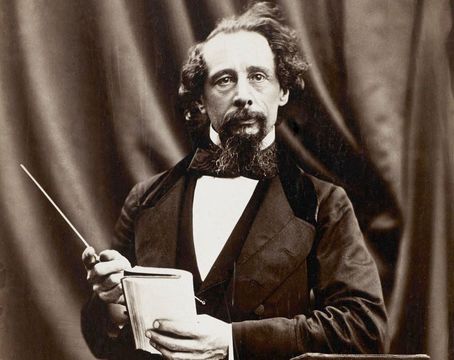
The great British writer, Charles Dickens.Herbert Watkins / Public Domain
On February 7, 1812, the great British writer Charles Dickens was born. Here Sian Ellis visits his birthplace of Portsmouth, on England’s south coast.
When Charles Dickens returned to Portsmouth in 1866, on one of his popular reading tours, he searched in vain for his birthplace. After some tomfoolery on the steps of a likely red brick home, he was chased away by an irate householder and merrily partook of a “restorative” brandy in a hostelry.
Today, the way to Charles Dickens’ Birthplace is well signposted, which is only courteous to the surge of fans who make a pilgrimage. Any subsequent trips to pubs will surely be for a celebratory toast to the master Victorian storyteller and world icon of British literature. In any case, Mr. Dickens provides an enticing passport to take a fresh look at “Pompey,” as the south coast city is affectionately known. I wiled away three whole leisurely days there!
Read more
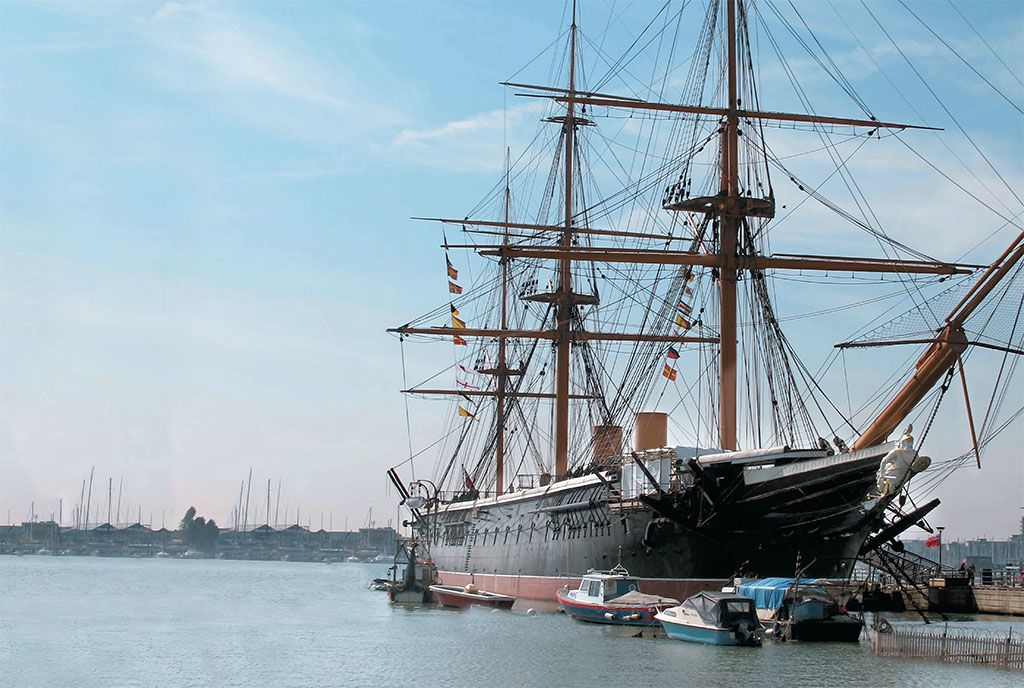
HMS Warrior, commissioned in 1861, was the world’s first iron-hulled, armor-plated warship. Largest and fastest battleship of its era, Warrior patroled the oceans and preserved the peace of the British Empire for 20 years.
Charles Dickens' Birthplace Museum
Dickens’ birthplace, now a museum, is tucked off the A3 into Portsmouth. Charles’ father, John, like so many people, came to work in the dockyard, and from 1809 to 1812 lived with his wife Elizabeth in a terrace on what is now Old Commercial Road. Charles John Huffam Dickens was born here on February 7, 1812.
I wandered through small rooms faithfully furnished in Regency style: fashionable mirrored overmantle in the parlor and Georgian glassware in the dining room. An exhibition room featuring choice pickings from the author’s later belongings—snuffbox, inkwell, a lock of hair, the green upholstered couch on which he died in Kent in 1870—color the story of his sweat-and-ink fame.
At the time the Dickens family was here, people were flooding into town to help service the war effort against Napoleonic France. John worked as a clerk in the Navy Pay Office and was relatively well remunerated, but his improvidence—a trait to be shared by fictional Mr. Micawber and Mr. Dorrit—meant that he was regularly in arrears of the £8 and 15 shillings a quarter rent. The family would move several times before John was recalled to work in London in 1815.
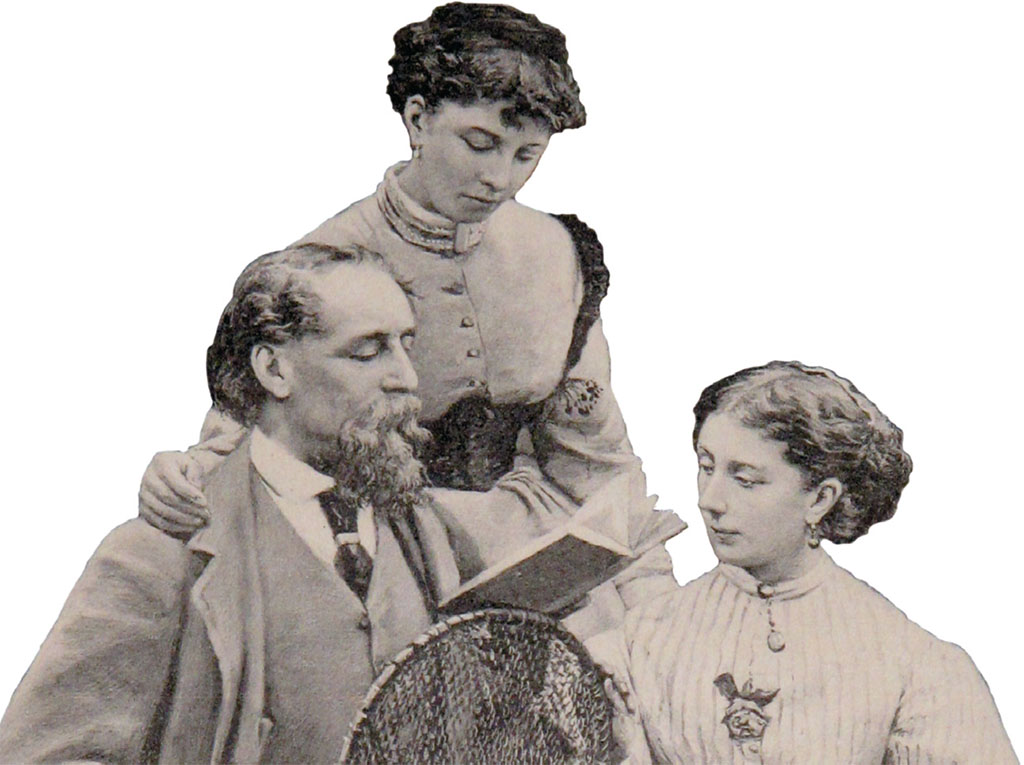
Charles Dickens enjoyed reading to his daughters, especially from his own works. Sian Ellis.
A tour of Dickensian nooks
At the Visitor Information Centre down on Portsmouth’s sea-salted waterfront, I met with Blue Badge Guide David Parker. The center has good leaflets on historic walking and cycling trails around the city, in the steps of Nelson and other renowned figures. Parker and his colleagues also lead walks (bookable through the center), so off we sauntered to a selection of Dickensian nooks, which he enthusiastically brought to life with period quotations.
Just inside Portsmouth Historic Dockyard, there’s the brick-built Navy Pay Office. We paused at two sites further on where the Dickens family lived (the passage of time and WW2 bomb damage call for some imagination to envisage what once was). Outside the erstwhile Beneficial School on Kent Street, now the home of the Groundlings Theatre, Parker narrated the story of Elizabeth Dickens attending a ball here and then rushing home to give birth to Charles.
Charles may only have lived in Portsmouth for three years, but he returned on three occasions,” Parker continued. “He came in 1838 to research local color for Nicholas Nickleby when it’s thought he took inspiration from the Theatre Royal—demolished in 1854—and modeled characters, including the theatrical manager Vincent Crummles, on local people. In 1858 and 1866, he came to give presentations of his work, which, as one newspaper reported, ‘afforded the utmost delight’.”
Armed with a graveyard map from Parker, I also mooched around Highland Road Cemetery. It’s a bit of a jaunt (you can catch the bus) and probably for keen fans only, but here you’ll find the plain graves of Maria Beadnell, Dickens’ first love and model for Dora in David Copperfield, and Ellen Lawless Ternan, the love of his final years—who is transformed into Helen Landless in the unfinished Mystery of Edwin Drood.
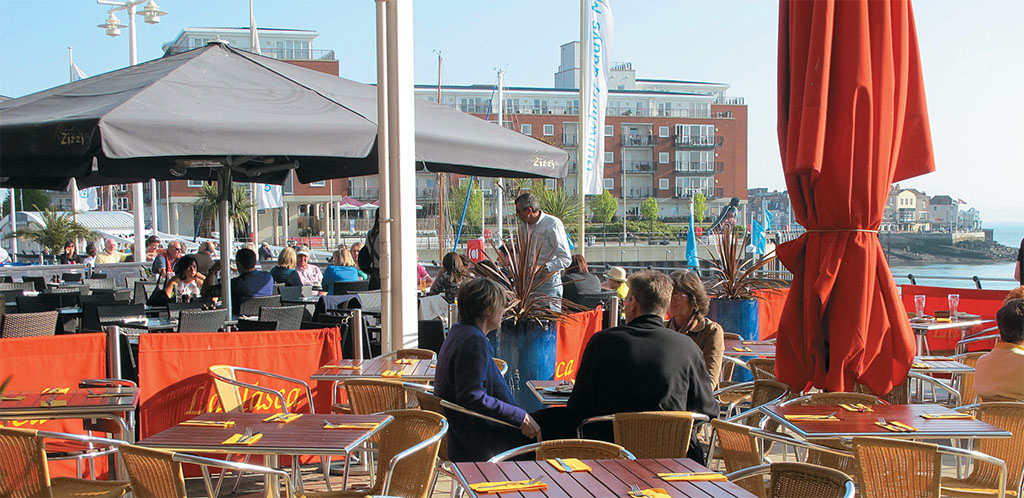
While Portsmouth is still home base to thousands of British sailors, it is the city’s many visitors who are apt to enjoy a drink in the evening sunshine outside the rank of cafes and restaurants that line Gunwharf Quay. Sian Ellis.
The mere fact that Portsmouth now has a Literature Development Officer shows just how seriously the city is beginning to take its heritage of wordsmiths. A Literature Map (view “what to see and do” at www.visitportsmouth.co.uk) locates the former homes of Susanna Rowson, Arthur Conan Doyle and Rudyard Kipling, and the former workplace of H.G. Wells, who distilled the experience of his unhappy apprenticeship at Southsea Drapery Emporium in The Wheels of Chance and Kipps.
Garrison and naval
On the bulbous peninsula of Portsea Island, however, there’s no escaping Portsmouth’s true raison d’être, as a garrison and naval settlement. It grew beside the huge, natural harbor, a key to defense and trade for Britons, Romans, Saxons, and Normans. In 1194, Richard I granted Portsmouth its first charter and ordered a dock to be built. The construction of the world’s first dry dock in 1495 and the official appointment of Portsmouth in 1512 as a building center for the king’s ships consolidated its strategic importance.
During the 18th century, the Royal Dockyard developed into the world’s greatest industrial complex, and in the heat of the French Revolution and Napoleonic Wars (1792–1815), it sweated at the leading edge of the Industrial Revolution. The growing populations of the fortified towns of Portsmouth and Portsea increasingly spilled into Landport and Southsea: the “Four Towns” of Portsea Island, as one 19th-century guidebook described them.
Today, almost two-thirds of the Royal Navy’s surface fleet is based at Portsmouth, and a visit to Portsmouth Historic Dockyard is a superb way to navigate through England’s naval history. I began at the Mary Rose Museum, which recounts the capsizing of Henry VIII’s favorite warship during a skirmish with the French in 1545, as the horrified king watched from South-sea Castle. Built at Portsmouth 1509–11, Mary Rose was one of the earliest warships to carry heavy guns, and her sinking has never been fully explained. Pore over some of the 17,865 superbly conserved objects retrieved from the silt of the Solent 1978–82: bronze guns and iron shot conjure a vessel ready for battle; a medicine chest of chisels and bone gouges lays bare grisly truths; leather shoes, pewter plates, and nit combs raise the personal ghosts of those who drowned.
HMS Victory
Next, I headed for the world’s oldest commissioned warship, HMS Victory, looking resplendent in her black and yellow livery. Built (at Chatham) 1759–65, Victory was designed to deliver shattering broadsides from guns on three decks. Her greatest hour came at Trafalgar 1805 when British ships led by Vice Admiral Lord Nelson crushed a combined French and Spanish fleet—destroying any Napoleonic ambitions of invading Britain.
“Follow the blue signs, mind your head on the low ceilings and try to get ahead of the French,” a smart Navy Uniform beside the gangway advised in deadpan Nelsonian undertones as he handed me a guide to Victory. I bounded past a garrulous gaggle of French students and explored at leisure: decks crammed with guns, the table on which Nelson wrote his final prayer on the eve of Trafalgar, and the spot on the quarterdeck where he fell mortally wounded.
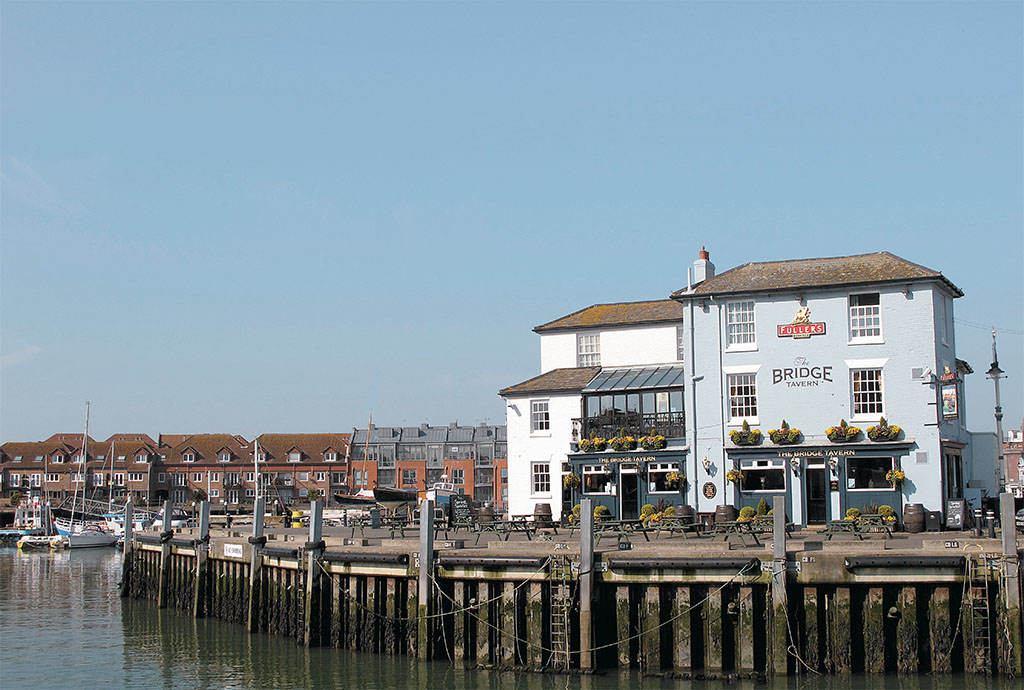
The Bridge Tavern makes a good spot for refreshment along the waterfront’s Millennium Promenade Walk. Sian Ellis.
Trafalgar Experience
The Trafalgar Experience in the National Museum of the Royal Navy elaborates on the great battle, or head on through time to HMS Warrior: “a black vicious ugly customer as ever I saw, whale-like in size and with as terrible a row of incisor teeth as ever closed on a French frigate,” as Dickens described her. Completed in 1861, the iron-hulled, armor-plated, Warrior was the largest, fastest, and most powerful warship in the world. I stopped to watch Bill White, dressed in the ceremonial uniform of a Victorian sailor, fascinating visitors with a small-arms demonstration. Such perfectly pitched interpretations are among the genuine delights of the Dockyard.
Boat tours around the harbor and many more treats mean you can easily spend a whole day at the Historic Dockyard. Then, what else to do in Pompey?
The City Museum on Museum Road tells a good general story of Portsmouth with likable intimacy: from displays on piers, pubs, parks and all the fun of Southsea, which took off as a seaside resort in the latter 19th century, to the standout exhibition of Richard Lancelyn Green’s collection of all things Arthur Conan Doyle.
Read more
Gunwharf Quays
Also, take a trip up the sparkling white Spinnaker Tower at Gunwharf Quays, the centerpiece of the Renaissance of Portsmouth Harbour Project. The 170-meter icon affords views for 23 miles around, putting the city and busy sea traffic in perspective. Take off your shoes and “walk on air” across the glass floor on View Deck 100 meters above sea level. It’s rather unnerving!
Gunwharf Quays bounces with designer shopping, bars, and restaurants, upbeat with waterfront al fresco dining on sunny days.
I gathered a Millennium Promenade Walk leaflet from the Visitor Information Centre and enjoyed a rewarding saunter through the juxtapositions of old and new Portsmouth. Leave aside the uninspiring urban sprawl inland and make your way from the Dockyard to Gunwharf Quays and The Camber, the original Norman fishing settlement that still bustles with a fishing fleet and briny fish markets. Pause for waterside refreshment at The Bridge Tavern or Spice Island Inn, or dine on fresh fish at Abarbistro.
Old Portsmouth
In Old Portsmouth and along the seafront, you will find defensive towers, cobbles, and charming houses, the Anglican cathedral, the Royal Garrison Church where Charles II married Catherine of Braganza in 1662, and all manner of statues and memorials—not least to Nelson, who departed Portsmouth that final time September 1805 to join HMS Victory. In fact, the city is full of ships’ figureheads and statues—the new one to Charles Dickens seems overdue!
Clarence Pier stands like a vivid exclamation mark to the esplanade of Southsea, the neighborhood that emerged as a respectable, middle-class outlier to the rougher garrison and dockyard area. The Italianate villas and curvy lanes of Victorian architect Thomas Ellis Owen, “father of Southsea,” are still in evidence around Sussex Road and Sussex Terrace.
What a contrast, then, are the D-Day Museum and Overlord Embroidery on Clarence Esplanade, which reopens the dark days of the war. Absolutely packed with vehicles, maps, uniforms, dramatic footage, and recordings, plus touchingly personal memorabilia, the museum looks at all aspects of the Allied landings in Normandy, June 6, 1944—including the role played by Portsmouth manufacturers to provide equipment and parts for the Mulberry Harbours. The 272-foot Overlord Embroidery is a compelling tribute to the sacrifice of those who took part.
You might meet some veterans of Operation Overlord (they often visit during school holidays). I chatted with Mary, who nursed the wounded in Portsmouth, while Jim Tuckwell and Frank Rosier held me rapt with their vivid recollections of running up Gold Beach under fire—“It’s a terrible thing, an open beach, and having to keep going even when your friend gets shot.” Accounts are retold with humbling modesty and a heartfelt appreciation of life after the war.
Come to Portsmouth for Dickens 2012, or simply come; there’s plenty to inspire.
Visiting Portsmouth
The A3(M) puts Portsmouth 1.5 hours by road from London and direct rail services run from Waterloo (80 mins).
See Portsmouth’s official visitor website for travel, accommodation (small B&Bs to large 4-star hotels) and attractions information, plus a full calendar of Dickens celebrations through 2012, www.visitportsmouth.co.uk.
The Holiday Inn Portsmouth, Pembroke Road, in the city’s Southsea area is superbly located for easy visiting to the sights, with Old Portsmouth on the doorstep and Gunwharf Quays a dockside walk away. The Historic Dockyard is a 20-minute step and Charles Dickens’ Birthplace is less than a mile (five minutes by taxi/car). After sightseeing, the hotel restaurant, bar, and lounge offer comfortable relaxation. www.holidayinn.com/portsmouth.
* Originally published in 2008.





Comments